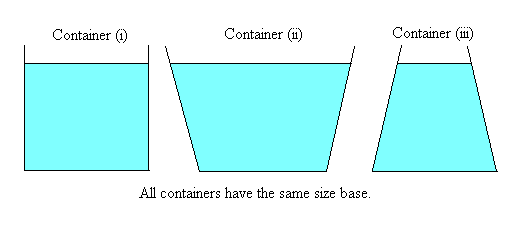(a) SG = SG(liquid) x fraction submerged

|
Height (m) |
t (s) |
vh = Ö 2gh |
sh = vht |
|
0.30 |
0.245 |
1.41 |
0.346 |
|
0.20 |
0.200 |
2.00 |
0.400 |
|
0.10 |
0.141 |
2.45 |
0.345 |

Upthrust = V r = 400000 x 1.3/1000 x 10 = 5200 NHelium balloon:
Weight of balloon = 200 x 10 = 2000 N
Weight of gas = V r = 400000 x 0.09/1000 x 10 = 360 N
Result: Nett Force = 5200 - 2000 - 360 = 2840 N
Upthrust = V r = 400000 x 1.3/1000 x 10 = 5200 NQuestion 37
Weight of balloon = 200 x 10 = 2000 N
Weight of gas = V r = 400000 x 0.18/1000 x 10 = 720 N
Result: Nett Force = 5200 - 2000 - 720 = 2480 N
Conclusion: Hydrogen balloon lifts only 1.14 as much as the helium balloon.

Question 44
For both balloons: Upthrust = weight of air displaced;
Weight of air = mass of air x g
Mass of air = density of air x volume of balloon = DairV
Weight of air (upthrust) = DairV x g
Weight of balloon and contents = (density of gas inside x volume x g) + (mass of balloon structure x g)
Weight (hydrogen balloon) = DHV g + mg
Weight (helium balloon) = DHeV g + mg
Lift = Upthrust - weight
Lift (hydrogen) = DHV g + mg - DairV x g
Lift (helium) = DHeV g + mg - DairV x g = 2DHV g + mg - DairV x g
Ratio: difference in lift/lift of helium
= ((-mg -DHVg + DairVg - (-mg -2DHVg + DairVg))/(-mg -2DHVg + DairVg)
= (-DHVg +2 DHVg)/(-mg - 2DHVg = DairVg)
= (DHV)/(-m - 2DH + Dair) x 100%
8% = (0.089 x 100)/(-m - 0.178 +1.20)%
8 = 8.9/(-m + 1.022)
8m = 0.724
m = 0.09 kg
NOTE: answer in back of book says 2.13 kg but this is wrong. My mistake.
Question 45
Too hard. Need extra maths formulas. Ask your maths teacher.
Question 46
Too hard. Need extra maths formulas. Ask your maths teacher.